Safety warnings – Groth 2100 User Manual
Page 4

3
SAFETY WARNINGS
This section is an overview of safety guidelines
that should be followed during the installation,
operation and maintenance of Groth Pressure
Emergency Relief Valves. To understand the
context of these instructions and warnings, it is
necessary to completely read and understand
the contents of this manual.
The purpose of an Emergency Relief Valve
(ERV) is to prevent excessive pressure in a tank
or process system. The valve must be designed
for the proper MAWP and flow requirements of
the system. Consult API Standard 2000 for tank
protection sizing procedures. An improperly
specified or functioning relief valve may result in
structural damage to the tank or system.
Do NOT attempt to remove the valve from the
tank or process vessel without first bleeding all
pressure from the system. ALTERNATIVE
MEANS OF PRESSURE RELIEF MUST BE
PROVIDED WHEN THE VALVE IS OUT OF
SERVICE.
The ERV is exposed to process vapors while in
service. Observe all plant procedures and
Material Safety Data Sheet (MSDS)
recommendations for the products in the system
when inspecting, adjusting or servicing the
valve. Take appropriate safety precautions
regarding eye protection, respiration and skin
contact.
SEE PAGES 4, 5, & 7 FOR ADDITIONAL
WARNINGS.
SHIPPING, INSPECTION AND
STORAGE
The ERV is normally bolted to a pallet during
shipping. When received inspect the valve for
any sign of damage that may have occurred in
shipment and report this to the carrier.
If the valve is to be stored before installation, it
should be in a clean environment and protected
to prevent intrusion of foreign materials into the
body. Before installation inspect the unit
visually. If there is any indication of physical
damage or internal contamination, the valve
must be cleaned and inspected before
installation.
Lifting eyes are bolted to the upper body flange
and are to be used for handling the valve. To
avoid damage to the lower flange surface, set
the valve on a soft clean gasket material until it
is ready to be installed.
INSTALLATION
The 2100 ERV must be handled carefully to
ensure seat tightness.
1. At installation, the valve should be smoothly
lifted into position using the lifting eyes on
the body flange. Do NOT lift the valve by
the spring assemblies; this can damage the
seat and cause the valve to leak in service.
2. The mating flanges on the valve body and
tank nozzle should be the same type (i.e.
RF with RF and FF with FF). Mating flanges
MUST be flat within .015" and clean, free of
scratches, corrosion and tool marks.
3. Begin by inspecting the gasket; make sure
that the material is suitable for the service.
Gasket dimensions are listed in the Table 1
below. Center the gasket on the tank nozzle.
WARNING: The valve must be installed in a
vertical position as shown in Fig. 1. To
achieve nominal flow capacity, the tank nozzle
bore must be at least the same nominal
dimension as the relief valve body.
